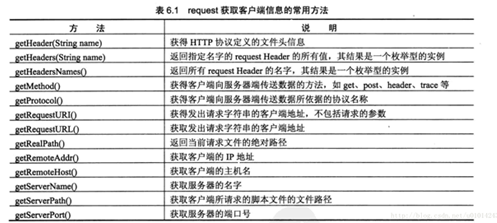request 对象是 httpservletrequestwrapper 类的实例。它的继承体系如下:

_request 对象继承层次结构图.png
servletrequest 接口的唯一子接口是 httpservletrequest ,httpservletrequest 接口的唯一实现类 httpservletrequestwrapper ,单从 request 对象一脉单传的类继承体系可以看出,javaweb 标准类库只支持了 http 协议。 servlet/jsp 中大量使用了接口而不是实现类,这恰恰就是面向接口编程的最佳应用啊。
request 内置对象是由 tomcat 创建的,可以用来封装 http 请求参数信息、进行属性值的传递以及完成服务端跳转,这就是 request 对象最重要的三个功能了。
request 对象的创建流程
一旦 http 请求报文发送到 tomcat 中, tomcat 对数据进行解析,就会立即创建 request 对象,并对参数赋值,然后将其传递给对应的 jsp/servlet 。一旦请求结束,request 对象就会立即被销毁。服务端跳转,因为仍然是同一次请求,所以这些页面会共享一个 request 对象。
1、访问请求参数
传递参数
login.jsp关键 代码
<%= "name:"+new string(request.getparameter("name").getbytes("iso-8859-1"),"utf-8") %>
<%= "sex:"+request.getparameter("sex") %>
<%= "id:"+request.getparameter("id") %>
<%= "pwd:"+request.getparameter("pwd") %> 说明:如果指定的参数不存在,将返回null;如果指定了参数名,但未指定参数值,将返回空的字符串"。
因为所有的request请求都是iso-8859-1的,而在页面采用的是utf-8编码方式,所以在遇到中文时,将获取到的数据通过string的构造方法使用指定的编码类型重新构造一个string对象。
2、在作用域中管理属性
在进行请求转发时,需要把一些数据传递到转发后的页面进行处理,这时,需要用request对象的setattribute方法将数据保存在request范围内的变量中。
<%
try {
int money = 100;
int number = 0;
request.setattribute("result", money / number);
} catch (exception e) {
request.setattribute("result", "很抱歉,页面产生错误!");
}
%>
<%= request.getattribute("result").tostring() %> 由于getattribute方法返回值是object,需要调用tostring方法转换为字符串。
3、获取cookie
cookie是小段文本信息,在网络服务器上生成,并发送给浏览器。通过cookie可以标识用户身份,记录用户名和密码,跟踪重复用户等。以键值对形式保存在客户机的某个目录下。
<%
cookie[] cookies = request.getcookies();
string user = "";
string date = "";
if (cookies != null) {
for (int i = 0; i < cookies.length; i++) {
if (cookies[i].getname().equals("mrcookie")) {
user = urldecoder.decode(cookies[i].getvalue().split("#")[0]);
date = cookies[i].getvalue().split("#")[1];
}
}
}
if ("".equals(user) && "".equals(date)) {
%>
游客您好,欢迎您初次光临!
请输入姓名:
<% } else { %>
欢迎
<%=user%> 再次光临
<% }%> deal.jsp:
<%
request.setcharacterencoding("gb18030");
string user = urlencoder.encode(request.getparameter("user"), "utf-8");
cookie cookie = new cookie("mrcookie", user + "#" + new date().tolocalestring());
cookie.setmaxage(60 * 60 * 24 * 30);
response.addcookie(cookie);
%>
window.location.href = "index.jsp"
4、获取客户端信息

客户提交信息的方式:<%=request.getmethod() %>
使用的协议:<%=request.getprotocol() %>
客户端地址:<%=request.getrequesturl() %>
客户端ip地址:<%=request.getremoteaddr() %>
服务器端口号:<%=request.getserverport() %>
服务器名称:<%=request.getservername() %>
客户端主机名:<%=request.getremotehost() %>
客户端所请求的脚本文件的文件路径:<%=request.getservletpath() %>
http协议定义的文件头信息host的值:<%=request.getheader("host") %>
http协议定义的文件头信息user-agent的值:<%=request.getheader("user-agent") %>
http协议定义的文件头信息accept-language的值:<%=request.getheader("accept-language") %>
请求文件的绝对路径:<%=request.getrealpath("index.jsp") %>

5、显示国际化信息
浏览器可以通过accept-language的http报头向web服务器指明它所使用的本地语言。java.util.local类型对象封装了一个国家和国家所使用的一种语言。示例如下:
<%
locale locale = request.getlocale();
string str = "";
if (locale.equals(locale.us)) {
str = "hello,welcome to access our company's web!";
}
if (locale.equals(locale.china)) {
str = "您好,欢迎访问我们公司网站!";
}
%>
<%=str%>- jsp+servlet实现文件上传与下载功能
- EJB3.0部署消息驱动Bean抛javax.naming.NameNotFoundException异常
- 在JSP中使用formatNumber控制要显示的小数位数方法
- 秒杀系统Web层设计的实现方法
- 将properties文件的配置设置为整个Web应用的全局变量实现方法
- JSP使用过滤器防止Xss漏洞
- 在JSP页面中动态生成图片验证码的方法实例
- 详解JSP 内置对象request常见用法
- 使用IDEA编写jsp时EL表达式不起作用的问题及解决方法
- jsp实现局部刷新页面、异步加载页面的方法
- Jsp中request的3个基础实践
- JavaServlet的文件上传和下载实现方法
- JSP页面的静态包含和动态包含使用方法




